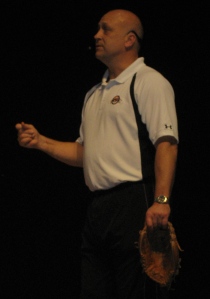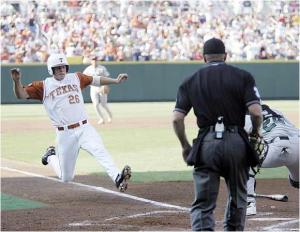Guest Blogger Kyle Provost breaks down the importance of taking the proper lead off third base.

Game Scenario
Imagine being just ninety feet away from scoring the tying run of the biggest game of the season. The game has been well played with stellar defense and great small-ball baseball strategy. The pressure mounts for the hitter, who faces a full count with the game on the line. With the pitch on the way most would argue that the game is solely on the shoulders of the hitter at the plate. As is often the case, the importance of sound baserunning is forgotten. We’ll get back to our game situation in a bit. First…some general advice on taking your lead.
Know The Situation
As a baserunner it is crucial to be aware of your role in dozens of situations. It could mean sliding to one side of second base to break up a double play or knowing the outfielder’s arm strength in case you need to advance on a fly out. Baseball seems to be full of surprises, and you need to be ready for every possible scenario.
Taking Your Lead
It is important to take all of the precautionary steps when leading off of a base, while at the same time adding some calculated risk to gain that competitive edge. Take your lead far enough to be a distraction for the pitcher, but within a hangnail’s reach of getting back on a pick-off attempt. Also, make sure you increase your lead when the pitcher commits to throwing home. This is most commonly referred to as the secondary lead. This will give you a greater chance of advancing to the next base if the situation arises to do so. A secondary lead can mean the difference of scoring from second on a single, getting home on a wild pitch or passed ball, or even increasing your chances to break up a potential double play.
Leading the Comeback Charge!!
Back to our game…The runner at third began his lead in foul territory of the baseline, which proved crucial to what was about to transpire. With the game on the line, the hitter roped a solid groundball down the third base line, hitting the runner directly in the foot. Because the runner took his lead in foul territory, the ball is considered dead on contact. The runner would have been ruled out if his feet were in fair territory.
The batter had new life, which resulted in an RBI single and an eventual win for a smart base-running squad. In the end, it was a matter of making the right decisions on the base paths that allowed for some heroics.
Bonus Tip
Once a ball hit to third has passed the runner in fair territory, the runner should move to the inside part of the base path to block the third baseman’s throwing lane to the catcher. If the ball strikes a runner on any throw, then the ball is still considered live and no outs are recorded.
Blogger Bio
Kyle has been around baseball for the past twelve years of his life as player, manager, league owner, and even radio broadcaster. Kyle played for North Middlesex High School until he began his radio career in 2002. He was a play-by-play personality for Franklin Pierce University, Keene State University, and the New England Collegiate Baseball League in NH. After departing from NH, Kyle focused his efforts on creating one of the newest Boston-area based baseball leagues.
Along with his brother Jason Provost, Kyle formulated the Royal Rooters Baseball League, which was named after arguably the most famous Boston fans of all time. The RRBL is housed in mostly Boston suburbs including Reading, Cambridge, Wakefield, and Medford. The competitive woodbat baseball league is marketed as great baseball for weekend warriors. The league has grown to nine teams since its creation in 2005 and looks to add a tenth team in 2010. The players come from all over New England with experienced playing backgrounds ranging from former High School standouts, to former and current Division I, II, and III studs. You can find more information on RRBL’s website at www.royalrooters-baseball.com.





 *Cincinnati Reds Scout* Andy Swenson shares his Top 5 ways for youth ballplayers to improve their mental approach. Watch, Learn, Listen, Absorb, and Practice.
*Cincinnati Reds Scout* Andy Swenson shares his Top 5 ways for youth ballplayers to improve their mental approach. Watch, Learn, Listen, Absorb, and Practice.










